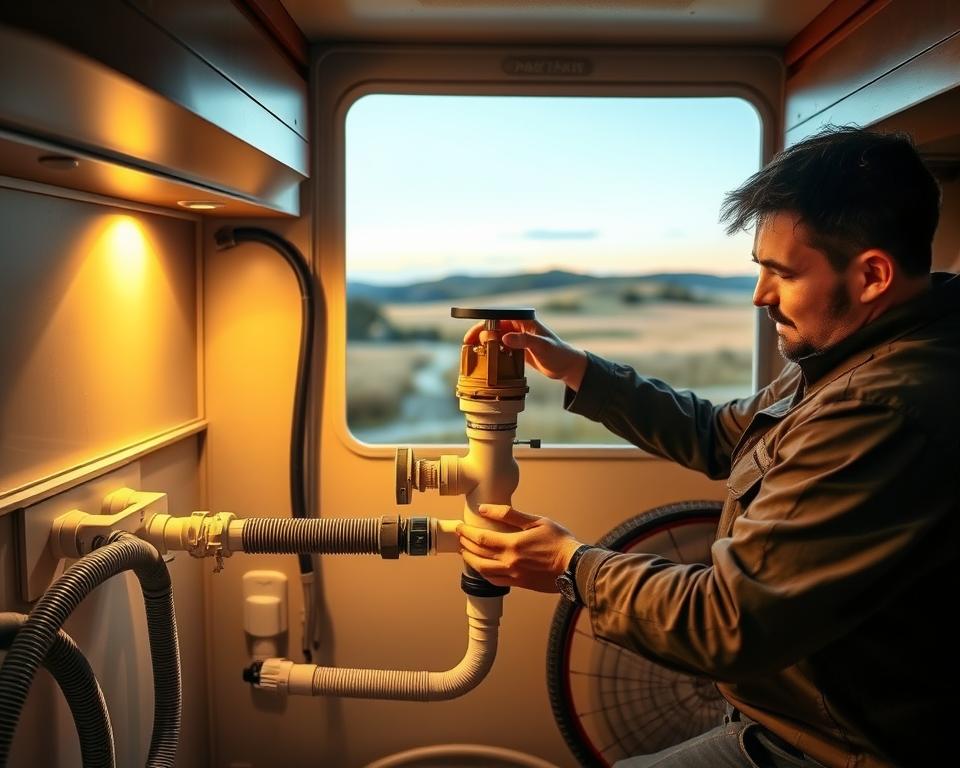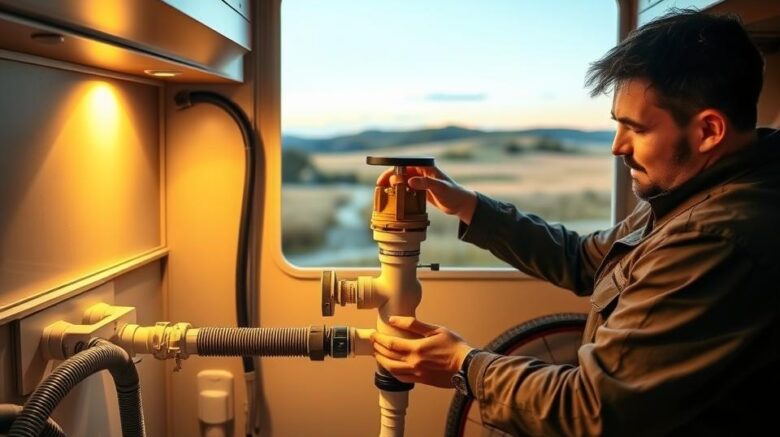RV Sewage Tank Pumping: Key Upkeep Guidelines
Imagine what happens when you ignore your RV’s sewer setup. Numerous campers feel intimidated by tank draining. Yet, recognizing the need for regular servicing is crucial. Such measures keep your trips worry-free and prevent costly fixes. Mastering correct waste handling is fundamental to your system’s longevity. Here are key pointers on mobile RV septic pumping near me with upkeep advice to ensure your system operates flawlessly.
Getting to Know Your RV’s Waste Setup
Your RV includes tanks designed for different wastes. It consists of a black tank for toilet use, a gray tank for sinks/showers, plus a freshwater reservoir. Grasping how each part works is key to proper black tank servicing and overall system care.
Drains and vents manage liquid and air movement throughout the system. Understanding this synergy helps you avoid blockages and buildup. This knowledge ensures hassle-free trips and reliable waste handling.
Maintaining clear, working tanks requires routine effort. Frequently checking tank levels and emptying on time preserves comfort. Proper upkeep extends tank life and enhances every journey.
Importance of Regular RV Septic Tank Pumping
Routine sewage draining preserves functionality and hygiene. Waste buildup triggers odors and backups that ruin outings. A full tank can produce embarrassing backups. These incidents mar your travel enjoyment.
Neglecting tank emptying invites expensive fixes. Damage from neglect can shorten component lifespan. Timely emptying keeps your plumbing running smoothly. You’ll avoid nasty surprises and costly breakdowns.
Proactive servicing stops clogs. Investing in pump-outs shows you care about your RV. It greatly improves your travel experience. By sticking to a dump schedule, you’ll relish the outdoors worry-free.
Recommended Pump-Out Intervals
Determining dump intervals needs careful thought. Common guidance suggests a 3–5-day window. However, it shifts based on tank volume and number of users. Knowing when to pump is vital for managing RV wastewater.
Empty once the black tank reaches roughly 66% full. It ensures good drainage and cuts down on odors. Skipping this leads to blockages and smells that spoil the trip.
Many elements can affect how often you pump:
- Number of people on board
- Length of stay
- Type of waste generated
- Tank capacity
Scheduling prevents on-the-road crises. Sync with any public dump station hours. Knowing your patterns predicts when to dump.
| Usage Scenario | Pumping Frequency |
|---|---|
| Short Trip, Two Campers | Every 3–4 days |
| Extended Trip (4–6 people) | Every 2–3 days |
| Seasonal Living (2–4 people) | Weekly or Bi-Weekly |
Keep a close eye on tank levels and your habits. Staying attentive guarantees a pleasant trip.

Top Methods for Emptying Your Tanks
Proper methods stop odors, clogs, and expensive repairs. Always empty the black tank first to protect the gray tank. It keeps gray water from mixing with solids.
Using a high-quality hose minimizes leaks and ensures smooth dumping. Tighten connections to stop spills. After emptying, flush the black tank with plenty of water. This removes residue and preps the tank for next time.
Scout dump spots along your route. This preparation streamlines your dump routine.
In short, follow these key steps for efficient dumping:
- Empty the black water tank first.
- Use a top-quality sewer hose.
- Flush the black tank thoroughly after emptying.
- Plan your dump station locations.
These tips refine your waste disposal process.
Tank Handling and Upkeep Best Practices
Knowing proper tank use and maintenance is crucial. Keep some water in the black tank for better breakdown.
Don’t flush wipes, feminine products, or paper towels. Use only RV-compatible paper. Inspect tanks often to catch problems early.
Occasional treatments boost system performance. They introduce microbes that digest solids effectively. Simple steps ensure smooth tank operation.
- Check for leaks and damage often.
- Apply RV-specific chemical treatments.
- Keep vents clear to avoid odors.
Following these rules protects your septic setup. You’ll enjoy more worry-free trips.
RV Septic Tank Pumping: Key Tips for Success
To pump your tank effectively, follow a methodical approach. It’s essential to use designated dump stations. Know your tank’s capacity to avoid overflows.
Check tank indicators regularly to time pump-outs. Routine scheduling preserves your septic system and travel enjoyment. A planned maintenance routine keeps everything running smoothly.
Flush well after every emptying. This clears residue for more efficient future pump-outs. By applying these strategies, you’ll maintain your RV’s condition and comfort.
Avoid These Septic System Errors
Upkeep prevents trip interruptions. Not using enough water in the black tank leads to buildup. Proper flushing dissolves waste better.
Flushing inappropriate items blocks pipes. Avoid non-dissolvable products like feminine hygiene items. Such mistakes can damage plumbing and inflate repair bills.
Keep the black tank valve closed until ready to dump. Premature opening prevents a full flush. This ensures solids clear on each dump.
Awareness of these errors boosts system longevity. Steering clear of these mistakes ensures durable performance.
When to Seek Professional Septic Services
Recognizing the need for expert help extends tank life. Persistent odors often indicate complex issues. Tanks that empty sluggishly hint at internal blockages.
Waste spillage near dump sites signals trouble. Such situations usually need high-pressure cleaning. Experts use specialized tools to clear stubborn clogs.
Routine professional inspections catch hidden issues early. Acting on findings quickly prevents bigger problems. Hiring qualified technicians saves time and money long term.
Long-Term Maintenance for Your RV Wastewater Management
Smart upkeep ensures lasting system performance. Scheduled dumps preserve longevity and operation. Routine rinses clear residue and stave off expensive breakdowns.
Implementing clean cycles safeguards tank health. Checking seals and joints avoids leaks. Opting for biodegradable products protects plumbing.
Keep these habits in mind:
- Stick to a pump-out timetable.
- Rinse often to remove solids.
- Sanitize twice a year.
- Inspect parts frequently for wear and tear.
Investing in prevention brings peace of mind. Through consistent upkeep, you’ll enjoy travel free from waste worries.
Final Thoughts
Good septic care ensures enjoyable trips. Knowing system function and cleaning steps stops issues. Regular black tank maintenance improves efficiency. This makes your journey more comfortable.
Consistent inspections and care deliver trouble-free trips. Dependable sewage service backs every adventure. Adopting these habits keeps your RV ready to roll. Thus, you can concentrate on adventures rather than septic concerns.
